Just imagine digging your toes into warm white sand, peering out over a turquoise ocean while listening to the water softly lap at the shore. A warm breeze momentarily takes away the heat of the sun … your eyes remain fixated … watching, waiting.
The water is so clear, you feel as though you can count every grain of sand below the surface. Every shadow, every smudge in the water comes alive. Your mind is playing tricks, because the thing you’re longing to see just never seems to appear.
Then, just as you feel hope slipping and you begin to consider taking solace in the shade, something extraordinary happens. Out of the corner of your eye, a dark shape appears, moving at a pace that you cannot yet comprehend. You question yourself … is it real? Is this really happening?
Then you realise it is, and you’d better start running!
A Magnificent Species
“Welcome to the Hotel California … such a lovely place, such a lovely place …”
Baja California Sur, home to that hotel and also to one of the most revered species in the fly-fishing world – pez gallo, most commonly known as the roosterfish.
It’s a magnificent species that’s not only stunningly beautiful but is equally voracious. It draws anglers to Baja from all over the world just to try their hand at catching one … but why?
The ocean resembles a massive salty pond teeming with life and bait. Unlike anywhere else in the world, the roosterfish in Baja will cruise in calm waters close to the shores of their pristine beaches. Best of all, they often come so close to shore to eat that they’re within easy casting distance of a fly rod.
As a professional fly-fishing guide in the South Island, my year would usually consist of summers in NZ and winters overseas chasing new and exciting species I can catch on the fly. Saltwater fly fishing was, and still is, an alluring mystery for me. After chasing bonefish and giant trevallies in Aitutaki, redfish and tarpon in the USA, and kingfish closer to home, I officially had the salt bug.
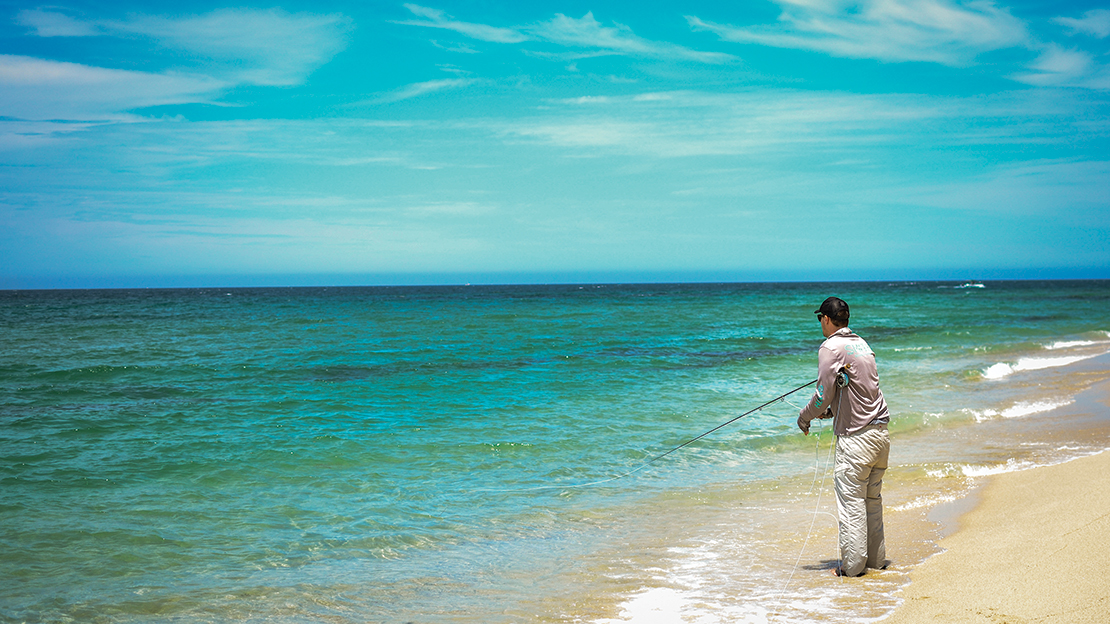
Baja California Sur
I’ve never been a fan of standing on boats all day, so when I came across the idea of chasing a big saltwater species on the beaches of Mexico, I knew I had to get there as soon as possible. It was 2018, and my guiding season had come to an end; packing my rods, I set off on a new type of adventure.
I spent the first few weeks exploring Baja with my partner. Landing in Cabo, we were met by an impending typhoon; as we waited for the skies to clear, we were free to soak in the culture, food and arid landscape Baja is famous for.
I moved on to the East Cape, taking time to settle in, while my partner headed home to New Zealand; I spent the next two weeks in search of what I was yet to understand.
How to Find a Roosterfish
The beauty of Baja beach fishing is its simplicity. A vehicle – ATV or 4WD – a 10wt rod and plenty of fluids are all you need to get out and start hunting down fish. You really have no idea where to start, so you just head to the most promising-looking beach, park up and start watching.
Initially, you’re not sure what you’re looking for and what a rooster would look like in the water. But trust me, when one appears, you won’t be second guessing yourself anymore.
A rooster moves through the water like a big black spaceship would slice through the sky, only pausing to devour any unlucky baitfish in its path. The iconic ‘comb’ on a rooster’s back has its purpose: to confuse and rile up its prey before it strikes.
Sometimes, you get lucky and see one in full action as it drives bait to the shore, puts it comb high in the sky and thrashes around in the shallows as bait flies in every direction in feeble attempts to escape.
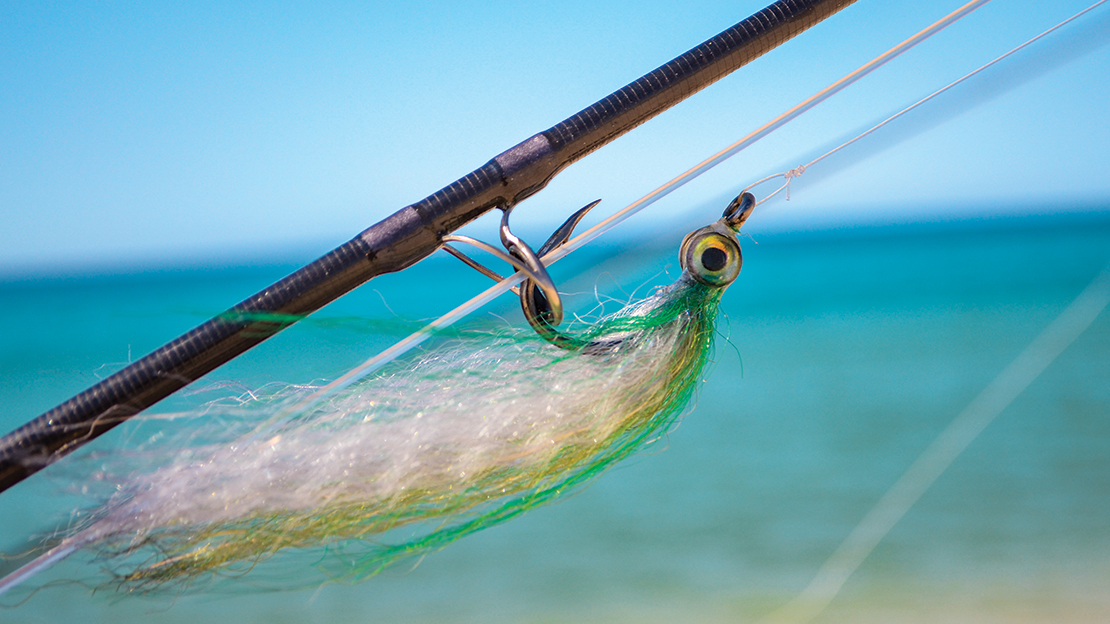
To Catch a Rooster
So how do you catch one on a fly rod? The answer is simply timing.
Once you see a rooster, you need to get in front of it, then cast back to the fish and strip the fly along its swim path. Now, as I said, these fish are fast! Which often means running like a headless chicken up and down the beach in an attempt to get in front of the fish and just hope it comes within casting range by the time you’re in position. More often than not, the fish either doesn’t come in close enough, or drifts away just as it reaches you. But sometimes, just sometimes, something magical happens.
It was my last day in Baja; I’d spent a week on the beach learning the ins and outs of how to spot and cast to a rooster. With many fly refusals, failed hooksets, and heart-crushing losses right at the beach, I was both desperate and almost defeated, but I still had one last day …
My mate, who’d joined me from the US, had already given up on the dream to get a rooster on the beach, and instead, opted to head out on a boat for the day to catch some tuna. However, I felt like I needed to give it just one last go. So, I hired a cheap quadbike for the day, drove to the beach where I’d seen the most fish over my week of exploring, set up my umbrella and waited.
I’d been having some issues with my fly lines during the trip; they’d begun to crack and split along the length, exposing the inner braid, making casting a nightmare. So, after a few false casts, I realised my only option was to cut the line in two, remove the split pieces and tie it back together. This left me with a horrific and dodgy large knot in the line that struggled to even make its way through the guidelines.
I was worried.
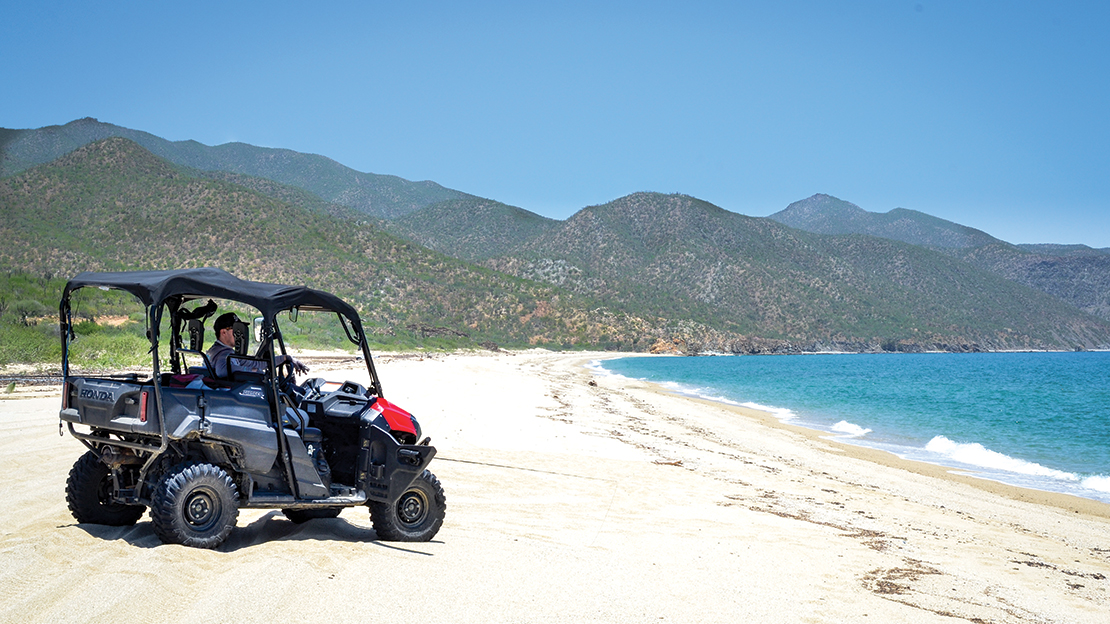
So Much Weight!
There had been a few fish come by during the morning, but they were a bit too far out of casting range. Then at 11:30am, as I was sitting on the quad having a drink, I noticed something dark off the deep ledge heading in straight for the beach. Taking no chances, I threw down my drink, grabbed my rod and sprinted down to the water’s edge. I could still make out the shape – big, black and coming straight towards me, which I thought was unusual as most fish I’d seen to date had swum parallel to the beach.
Within about 40 metres of the shore, it became obvious that this fish was on a mission, so I began false casting, getting my line in the air and ready to lay it down at the perfect moment. The front of the fish was now within several metres of my full-length cast, so I dropped it onto the water, let it settle for a second, then gave two long, hard strips. What happened next still haunts me to this day.
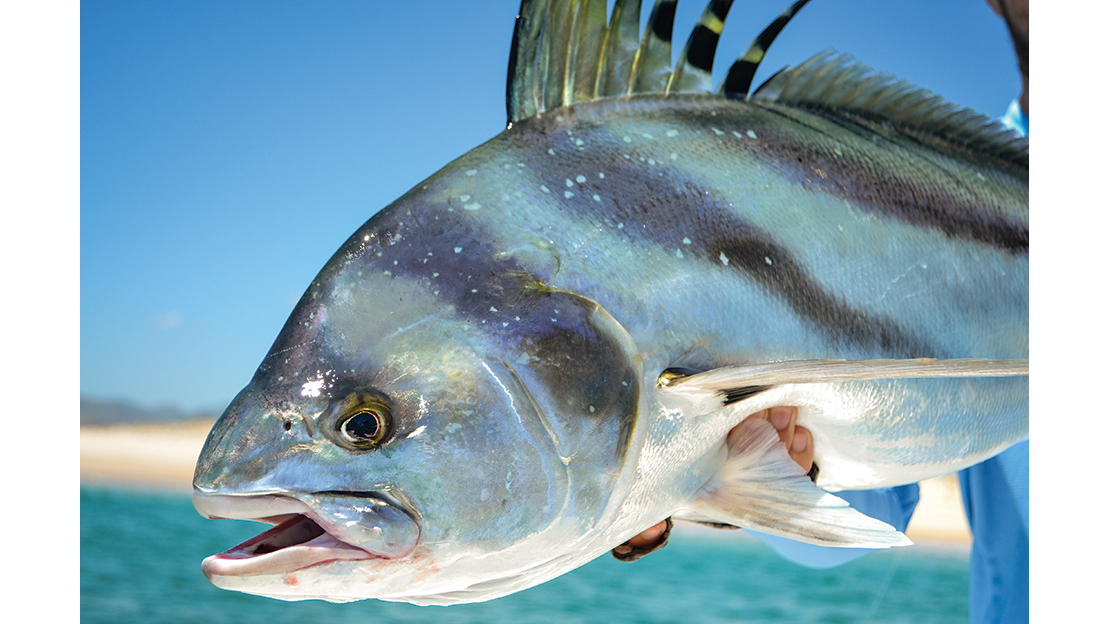
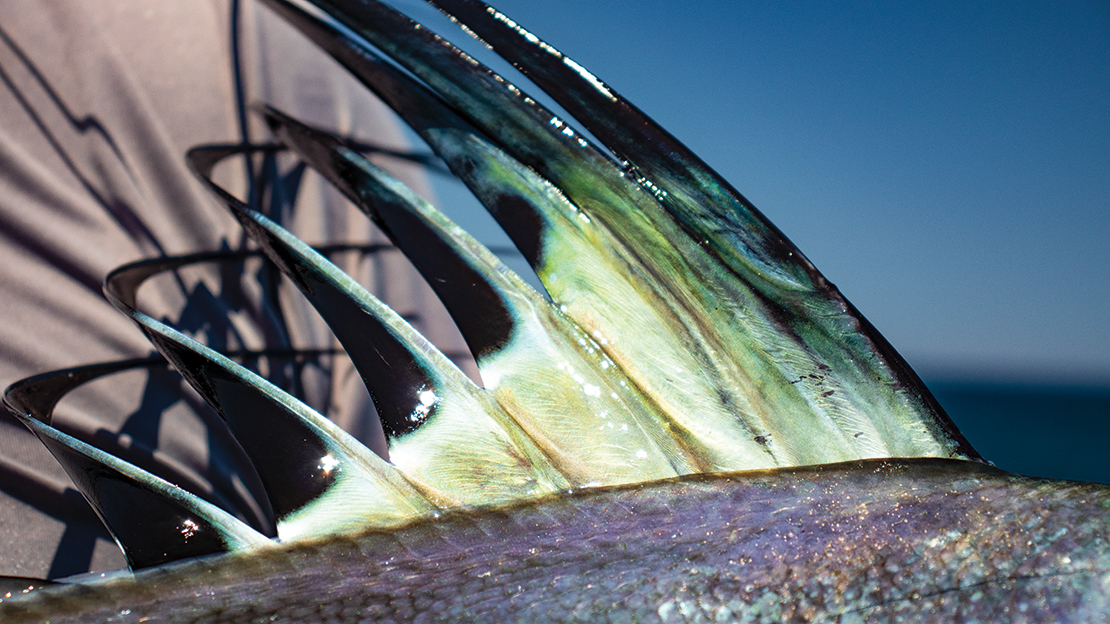
The fish saw the fly strip in an attempt to escape its path; it instantly sped up towards the surface. The comb came up, piercing the surface of the water as a massive white bucket mouth opened up in front of my eyes, wrapped around my fly and snapped closed. The fish then immediately turned 90 degrees and I felt the weight … so much weight!
He obviously felt the hook too and turned straight back out accelerating towards the deep, taking over 300 metres of line in a matter of seconds!
The beauty of the Baja beaches is that there’s no deep coral, weed or structure – just smooth, flat sand all the way out to the depths. So, once he was hooked, I knew the only way I could lose him was if that dreaded knot that I’d tied in my fly line came loose.
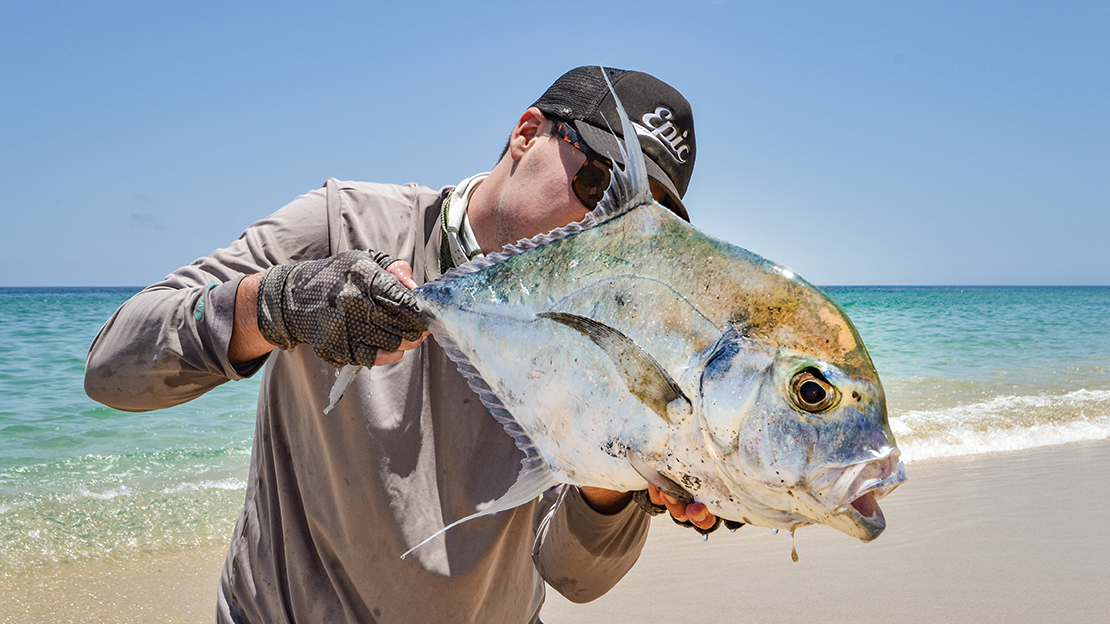
I was shaking like a leaf as I slowly manoeuvred the fish in an arcing motion, left to right, trying to coerce him back to the beach, only to be interrupted by vicious runs that could easily be bone crushing if you got your fingers in the wrong place around the reel.
After what felt like an eternity, I eased him in, swinging left to right in an elaborate tango, terrified of what might happen next. I now had the fly line back in sight and could see the knot approaching, so I ran into the water and frantically reeled it back onto the spool, only for it to immediately be stripped out again. This repeated several times before the fish finally came so close it began to be pushed in by the small waves.
This is the time when most roosterfish are lost, and I’d already lost one in the waves just days earlier, so I was on edge to say the least. I slowly worked him into what I thought was a wave that’d finally wash him up and allow me to secure his tail. The wave picked him up, pushing him up the beach and onto the sand.
As the water retreated, what lay there in front of me was what they call a ‘grande’, a roosterfish of 40lb+ in all its magnificent glory.
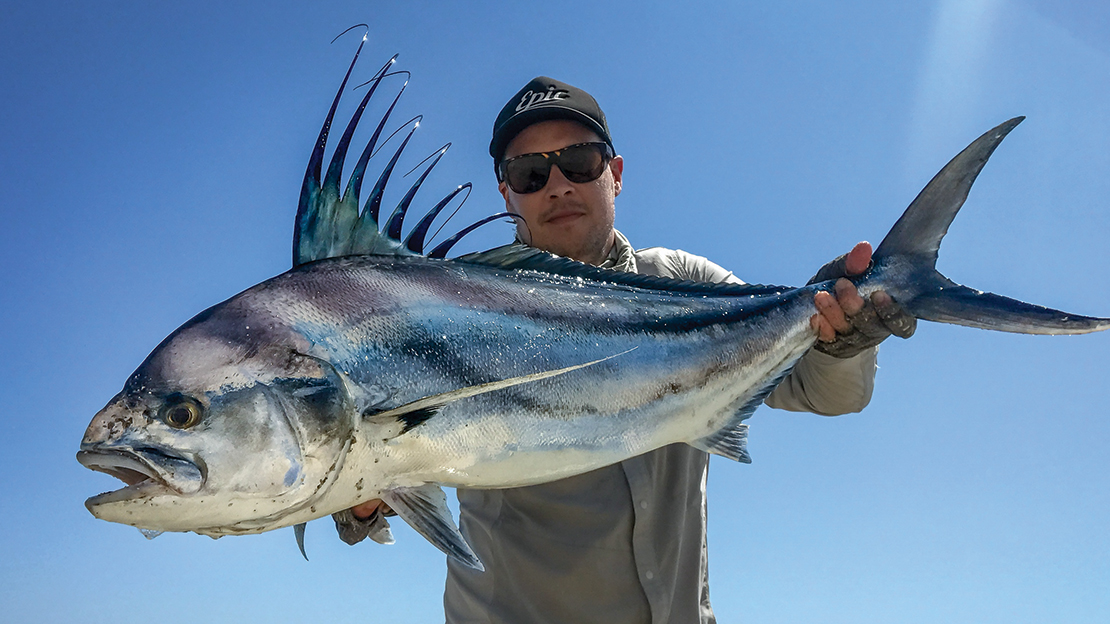
Record and Release
I quickly rushed down to grab the tail and slide the roosterfish back into the shallows to get water over its gills. The fish was as exhausted and breathless as I was, so we both sat there as the waves lapped at my back, just resting and soaking in the moment. I was so overwhelmed, I found myself shedding a tear in sheer disbelief that after all the pain and toil, the dream had come true – I’d landed a grande roosterfish on the beaches of Baja!
Luckily, I had my phone in my chest pocket. I quickly stuck it into the sand, reversed the camera, set the timer and took a photo. I then took the grande back out to waist-deep water and held him there until I felt the powerful kick return to its tail. I slowly released my hand, gave him a nudge forward and expressed my gratitude for what was one of the most intense and memorable moments in my fifteen years of fly fishing.
After a quick swim to soothe the nerves and come down off the epic high, I jumped onto the quad and headed back to town to partake in one last Mexican feast before preparing for my flight home the following day. My mate came back from his day on the boat with several yellowfin tuna in hand. We headed down to the bar to reminisce about the week that was, whilst devouring tuna sashimi and plenty of cold Mexican beer. My trip was complete.
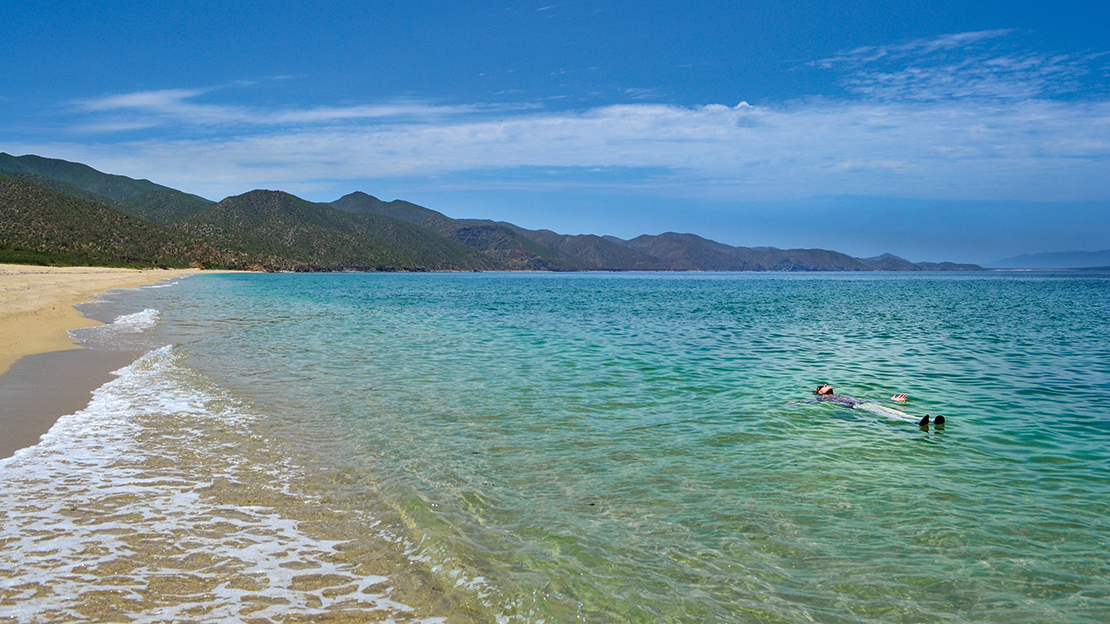
Have No Expectations
As you can see, fly fishing for roosters on the beaches of Baja is not for the faint-hearted. Not only is it extremely challenging fishing, but the conditions can be unbearable with it often being 35+ degrees on a normal day and sometimes over 40 on the worst.
Sometimes the wind can make life hell, and throwing big 4/0 hooks on a 10wt is a recipe for disaster. I found this out first-hand when on a windy day, I sunk a huge hook deep under my bicep muscle and had to endure a long tortuous journey to hospital to have it pushed through and cut off.
The key to a successful fishing trip is to head to Baja with no more expectations than to sit on the beach with a fly rod in hand by day and partake in the Mexican delicacies by night. The fact is the fishing is hard – very hard.
I returned in 2019 for a month, spending 20 days on the beach, and guess what? I didn’t land a rooster, or even hook one, until the very last day. It’s almost like Baja wants to push me to my breaking point before rewarding me with its ultimate prize ensuring I’ll always return.
Now, after two years of being stuck in New Zealand due to border restrictions and having my 2020 trip to Baja cancelled, I’m off once again – back to the place that can make and break your heart on the same day … the place that’s what you make of it … a place that puts a smile on your face whenever it comes to mind. That place is Baja California Sur.
“Welcome to the Hotel California … such a lovely place, such a lovely place …”

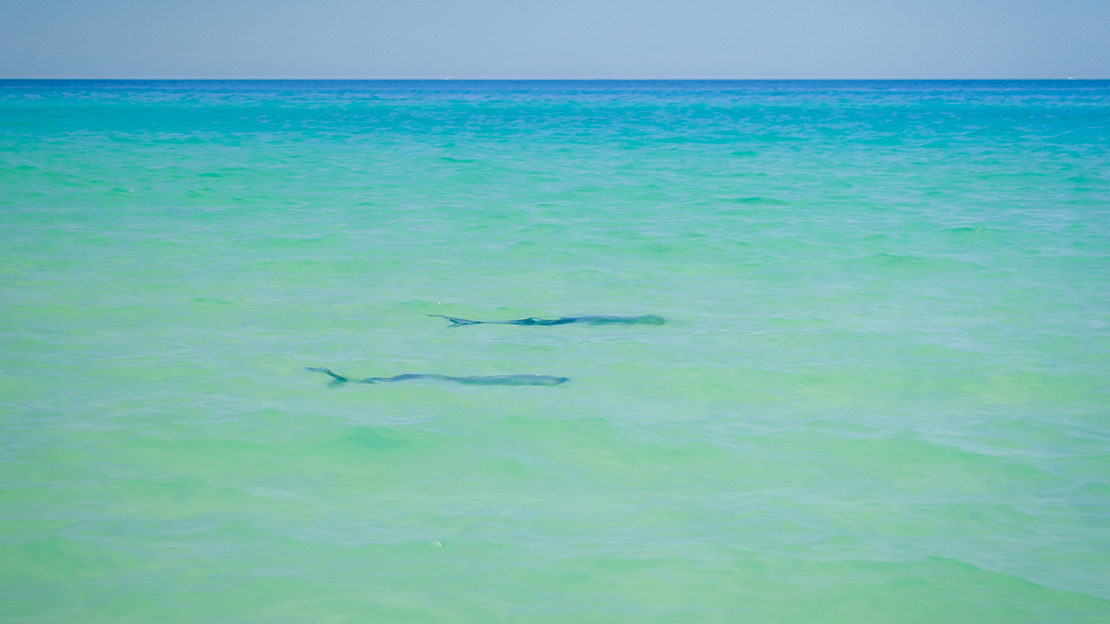
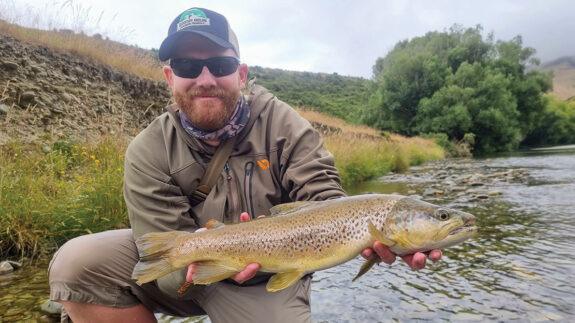
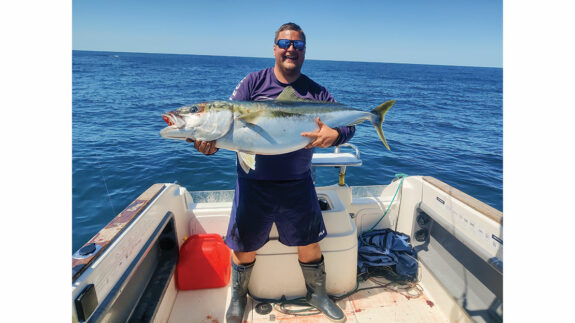



SHARE YOUR BEST PICS #NZRODANDRIFLE